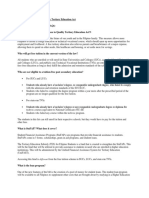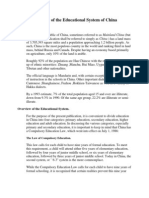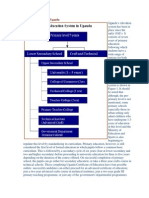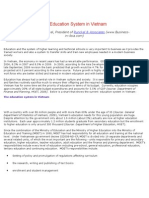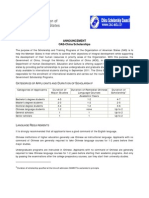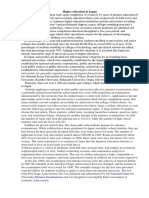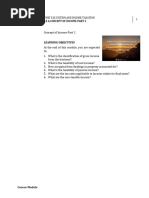0 ratings0% found this document useful (0 votes)
Health and Education
Health and Education
Uploaded by
Mary Jane TognoThe document provides an overview of China's education system from primary to tertiary levels. It discusses that primary education lasts 6 years and is compulsory, with Mandarin Chinese as the primary language of instruction. After primary school, students can attend 3-year junior secondary schools, followed by 3-year academic or vocational senior secondary schools. Vocational programs are also offered at secondary and post-secondary levels. Higher education is provided at universities and other institutions, with entry depending on national exam scores.
Copyright:
© All Rights Reserved
Available Formats
Download as DOCX, PDF, TXT or read online from Scribd
Download as docx, pdf, or txt
Health and Education
Health and Education
Uploaded by
Mary Jane Togno0 ratings0% found this document useful (0 votes)
The document provides an overview of China's education system from primary to tertiary levels. It discusses that primary education lasts 6 years and is compulsory, with Mandarin Chinese as the primary language of instruction. After primary school, students can attend 3-year junior secondary schools, followed by 3-year academic or vocational senior secondary schools. Vocational programs are also offered at secondary and post-secondary levels. Higher education is provided at universities and other institutions, with entry depending on national exam scores.
Original Description:
health and education
Copyright
© © All Rights Reserved
Available Formats
DOCX, PDF, TXT or read online from Scribd
Share this document
Did you find this document useful?
Is this content inappropriate?
The document provides an overview of China's education system from primary to tertiary levels. It discusses that primary education lasts 6 years and is compulsory, with Mandarin Chinese as the primary language of instruction. After primary school, students can attend 3-year junior secondary schools, followed by 3-year academic or vocational senior secondary schools. Vocational programs are also offered at secondary and post-secondary levels. Higher education is provided at universities and other institutions, with entry depending on national exam scores.
Copyright:
© All Rights Reserved
Available Formats
Download as DOCX, PDF, TXT or read online from Scribd
Download as docx, pdf, or txt
0 ratings0% found this document useful (0 votes)
Health and Education
Health and Education
Uploaded by
Mary Jane TognoThe document provides an overview of China's education system from primary to tertiary levels. It discusses that primary education lasts 6 years and is compulsory, with Mandarin Chinese as the primary language of instruction. After primary school, students can attend 3-year junior secondary schools, followed by 3-year academic or vocational senior secondary schools. Vocational programs are also offered at secondary and post-secondary levels. Higher education is provided at universities and other institutions, with entry depending on national exam scores.
Copyright:
© All Rights Reserved
Available Formats
Download as DOCX, PDF, TXT or read online from Scribd
Download as docx, pdf, or txt
You are on page 1/ 8
China Education System
Primary Education
In China, primary school education is compulsory and it lasts 6
years. Children start schools at age six (seven in some areas).
The language of instruction is Mandarin Chinese with the
exception of the primary schools that mainly admit ethnic
minority students. A typical school year is comprised of two
semesters and runs from the month of September to July. Students
attend classes five days a week and primary school education
currently includes nine compulsory courses, which include
Chinese, Mathematics, Social Studies, Nature, Physical
Education, Ideology and Morality, Music, Fine Art, and Labor
Studies. Foreign Language is normally offered as an elective
course. In order to graduate, all students are required to pass
graduation examinations in the subjects of Chinese and
Mathematics. The examinations are normally designed and
administered by schools with guidance from local educational
authorities. Students move on to 3-year junior (lower) secondary
schools after graduating from primary schools.
Middle Education
Junior (lower) secondary education lasts three years following
the completion of primary school. In order for students to
obtain a certificate of graduation, students are required to
pass graduation examinations and meet minimum physical education
standards. The graduation examinations are designed and
administered by individual schools according to guidelines set
by the provincial educational bureaus or by local educational
authorities. Students are typically examined in the following
subjects for graduation: Chinese, Mathematics, Chemistry,
Physics, Foreign Language, and Politics. Completion of junior
(lower) secondary education also marks the end of a 9-year (6+3)
compulsory education program.
Secondary Education
After the completion of junior (lower) secondary school,
students can choose to enter either general (academic) senior
secondary school or vocational senior secondary school. General
(academic) senior secondary school lasts 3 years and vocational
senior secondary school lasts 3 or 4 years. Senior secondary
school is known as and vocational senior secondary school is
known as in China. Students wishing to continue their study in
the general (academic) track must pass the entrance examinations
for general senior secondary schools, which is also known as
China. Designed and administered by provincial educational
authorities, the entrance examination includes the same subjects
as the junior secondary graduation examination. At the end of
their final school year, graduates of senior secondary schools
seeking admission to post-secondary education are required to
take the National Higher Education Entrance Examination, also
called National College Entrance Examination (NCEE), commonly
known as in China.
Vocational Education
Vocational education programs are offered at both the secondary
and post-secondary levels. Vocational senior secondary schools
provide subject and occupation specific education and training.
Vocational senior secondary education is highly employment
oriented and graduates normally enter the workforce. However, it
does offer some access to further education, particularly in the
technical/vocational specialties. Since the year 2000, the
Ministry of Education (MOE) has allowed graduates of vocational
secondary schools to take the NCEE and be admitted into higher
education programs.
Higher technical/vocational education is available at the level,
which require two or three years of full-time post-secondary
study. It is possible for graduates of higher vocational
education programs at the zhuanke level to obtain a "benke 本科"
degree (Bachelor’s degree) certificate through an upgrading
program, but in a limited number of fields. Vocational higher
education institutions are currently administered at the
provincial level.
Tertiary Education
Higher education is provided by institutions of various types
including general and technical universities, specialized
institutions, professional universities, military institutions,
medical schools and colleges, independent colleges, and adult
higher education institutions of various types. Entry to
university depends primarily on how well the students perform in
the entrance examinations. Students with outstanding academic
performance in their secondary schools can also possibly be
granted an exemption from the entrance examination and be
recommended directly to the university of their choice through a
method called (baosong 保送). In addition, some private
institutions are exempted from the NCEE (gaokao) and accept all
students who can afford the tuition fees. Prestigious
universities (key institutions) maintain higher admission
standards, and therefore require higher NCEE (gaokao) scores
than other institutions. Entry to higher education in China is
highly competitive.
THE CHINESE HEALTHCARE SYSTEM: HOW IT WORKS AND FUTURE TRENDS
E D O A R D O M A R I A N O F R I 1 3 NOVEMBRE 2015 0
GENERAL INTRODUCTION
Health care spending in China is increasing rapidly. According
to a Deloitte report released in 2015, the country’s annual
expenditure is projected to grow at an average rate of 11.8
percent a year in 2014-2018, reaching $892 billion by 2018.
Spending will be driven primarily by consumers’ rapidly
increasing incomes and the government’s public health care
reforms.
Despite these positive numbers, China’s health care spending, at
an estimated 5.4 percent of gross domestic product (GDP) in
2013, is still much lower as compared to OECD countries. The
country also has a large health care demand gap due to an aging
population, growing urbanization, proliferating lifestyle
diseases, rapidly increasing consumer wealth, and the
advancement of universal health care insurance. While all of
these elements are driving overall health care market expansion,
continued development cannot proceed without heavy investment by
and strong support from the Chinese government.
China is a vast country with uneven economic development. Rural
and urban residents are categorized separately according to the
household registration system (hukou), and the government
financing systems is different for the two categories of
citizens.
After the economic reforms started in 1978 China experienced
rapid economic growth in the past two decades, benefiting many
sectors of the economy. However, the economic success was not
mirrored in the healthcare system. The transition from a
centrally planned economy to a market‐oriented economy has caused
problems in the public health arena.
There have been several debates regarding China’s healthcare
reforms in recent years. Critics, composed primarily of
individuals from outside the Ministry of Health, have labeled
the past reforms as failures, attributing it to the excessive
dependence upon market mechanisms in the healthcare sector. Yet
supporters, composed of individuals from within the Ministry of
Health, have asserted that past reforms were relatively
successful, pointing to the fact that the problems associated
with the shortage of health services and drugs during the period
of the planned economy have largely been resolved.
In response to the emerging problems in its healthcare system,
China has made numerous attempts to rebuild universal coverage
system since the late 1990s. The health insurance system
collapsed in the late 1970s, and a great number of residents
left uninsured. Through decades of effort, the Chinese
government has developed three systems, in both urban and rural
areas, which provide coverage for more than 90% of the
population. The condition was especially troublesome in rural
areas, revealing sharp rural‐urban disparities in health
insurance coverage and related healthcare services and costs.
Starting from the late 1990s, the government established three
new health insurance systems. During the launch of each new
health insurance scheme, the government also proposed other
measures to provide more healthcare resources to the targeted
population. In 2009, the government started a new round of
healthcare reform. In the new round of reform, the major goal
was to provide universal coverage to all residents, and to
target on disadvantage population to improve the healthcare
service for them and reduce disparities.
According to a statement by the State Council, the goal of
universal coverage is to provide safe, effective, convenient,
and affordable basic medical services to all urban and rural
residents. One of the most important components of universal
coverage is health insurance. Before this goal of universal
coverage was officially introduced in 2009 with the Chinese
government’s announcement of the blueprint for health system
reform, health insurance reforms in both urban and rural areas
had resulted in greater health insurance coverage. Three major
health insurance schemes were established. The Urban Employees
Basic Medical Insurance (UEBMI) was launched in urban areas in
1998, and the Urban Residents Basic Medical Insurance was
launched in 2007. In rural areas, the New Rural Cooperative
Medical Insurance (NRCM) was established in 2003. Below follows
a brief introduction to each scheme.
The Basic Medical Insurance for Urban Employees
In 1998 was set the Urban Employees’ Basic Medical Insurance
System. This was the first step in re‐establishing the health
insurance system in urban areas. The Urban Employees Basic
Medical Insurance (UEBMI) is compulsory based on employment. It
provides basic medical insurance coverage for urban employees in
both the public and private sectors. Local governments, mainly
at the municipal level, set the level of deductibles,
copayments, and reimbursement caps according to local economic
levels. The UEBMI is financed by premiums from both employers
and employees. In their decision, the State Council suggested
that the employers’ contribution be 6% of the employee’s salary
and the employees’ percentage be 2%. The revenue collected from
premiums is distributed evenly into two independent accounts:
the medical Savings Account (MSA) and the Social Pooling Account
(SPA). All employees’ contributions and
about 30% of employers’ contributions go into the MSA, and the
remainder of the employers’ contributions goes to SPA. The two
accounts are managed separately and pay for different services:
the MSA covers outpatient and emergency services and drug
expenses, and the SPA covers inpatient services.
The Basic Medical Insurance for Urban Residents
In 2007, the State Council issued guidelines to launch the Urban
Residents Basic Medical Insurance (URBMI). According to the
guidelines, the URBMI covers primary and secondary school
students who are not covered by the UEBMI (including students in
professional senior high schools, vocational middle schools, and
technical schools), young children, and other unemployed urban
residents on a voluntary basis.
The main purpose of the guidelines is to provide coverage for
urban residents without formal employment with the intention of
eliminating impoverishment resulting from chronic or fatal
diseases, which can lead to catastrophic medical expenditures.
The URBMI was piloted in 79 cities. In 2010, this insurance
scheme was expanded nationwide and gradually extended to all
unemployed urban residents. The financing of this insurance
program mainly comes from participants’ premiums. The government
also provides a smaller amount of subsidies, compared to the
premium contributions. The premium of the policy is determined
by the local government, according to the local economic level,
the medical care expense level, and the participants’ household
income level. There are extra government subsidies for low‐income
families, disabled students, and young children.
The New Rural Cooperative Medical Insurance
In recent years, especially since the SARS outbreak in 2003,
healthcare reform, primarily in the rural regions of China, has
received unprecedented attention from the central government.
While a rural health insurance system had existed in China prior
to its economic reforms, it floundered during the early 1980s
primarily because of the collapse of the rural collective
economy. As a result, some 90% of the rural population was left
without any type of health insurance coverage. In 2003, the
State Council issued the decision to further enhance the rural
health care system, aimed at re-establishing the new rural
cooperative medical insurance (NRCM). The NRCM scheme covered
the rural residents on a voluntary basis in order to avoid
impoverishment caused by catastrophic expenses from infectious
and endemic diseases.
The NRCM was piloted in 2003 in selected counties. In 2010, the
NRCM covered more than 90% of all rural residents. The NRCM was
funded by premiums from both the insured and by subsidies from
the local and central governments. This was the first time that
Beijing had allocated funds from the central government budget
to support a rural health insurance plan. The NRCM provides
partial coverage for all kinds of medical expenses, excluding
some outpatient expenses and drug expenses. The reimbursement
caps vary by local economic development levels. The initiation
and expansion of the NRCM diminished the disparities in health
insurance coverage; however, it is still unknown whether the
expansion helped reduce disparities in other healthcare areas,
such as healthcare utilization and cost.
A brief overview of the three main insurance schemes is provided
in the table below, taken from RAND’s report on “China’s Health
Insurance Reform and Disparities in Healthcare Utilization and
Costs”
You might also like
- An Overview of the Chinese Education SystemNo ratings yetAn Overview of the Chinese Education System9 pages
- Overview of The Educational System of ChinaNo ratings yetOverview of The Educational System of China8 pages
- Corruption in Education in Bangladesh by Kowsarbhn@Gmail100% (3)Corruption in Education in Bangladesh by Kowsarbhn@Gmail8 pages
- Higher Education Finance and Cost-Sharing in Romania: I. A Brief Description of The Romanian Higher Education SystemNo ratings yetHigher Education Finance and Cost-Sharing in Romania: I. A Brief Description of The Romanian Higher Education System6 pages
- Pub - No.58 Education System of Bangladesh (Certificates, Diploma)No ratings yetPub - No.58 Education System of Bangladesh (Certificates, Diploma)36 pages
- Describe Your Country's Education System. What Is Your Attitude Toward This System, Do You Think It's EffectiveNo ratings yetDescribe Your Country's Education System. What Is Your Attitude Toward This System, Do You Think It's Effective1 page
- A Closer Look On The Education System of Selected CountriesNo ratings yetA Closer Look On The Education System of Selected Countries3 pages
- National Report Template MERIC-NET Algeria EnglishNo ratings yetNational Report Template MERIC-NET Algeria English22 pages
- 8-2024 Master Program of Educational Management and Policies (Northeast Normal University)No ratings yet8-2024 Master Program of Educational Management and Policies (Northeast Normal University)17 pages
- Educationsystemofbangladesh Topic 10 115No ratings yetEducationsystemofbangladesh Topic 10 11518 pages
- Bangladesh: at A Glance BANBEIS: at A Glance The Present Education System of Bangladesh100% (1)Bangladesh: at A Glance BANBEIS: at A Glance The Present Education System of Bangladesh16 pages
- A Closer Look On The Education System of Selected Countries100% (4)A Closer Look On The Education System of Selected Countries9 pages
- A Study On Higher Education in Bangladesh PDF100% (3)A Study On Higher Education in Bangladesh PDF15 pages
- Educational System of Related CountriesNo ratings yetEducational System of Related Countries97 pages
- Loan Application Guidelines For 2015/16 Academic Year100% (2)Loan Application Guidelines For 2015/16 Academic Year17 pages
- Educational System - Ministry of Education Republic of China (Taiwan)No ratings yetEducational System - Ministry of Education Republic of China (Taiwan)2 pages
- C A D S: Announcement OAS-China ScholarshipsNo ratings yetC A D S: Announcement OAS-China Scholarships7 pages
- Educational System of The Different Countries: 1.) Saudi ArabiaNo ratings yetEducational System of The Different Countries: 1.) Saudi Arabia14 pages
- Higher Education in Japan: Private UniversitiesNo ratings yetHigher Education in Japan: Private Universities2 pages
- Description of The Present Education System in BangladeshNo ratings yetDescription of The Present Education System in Bangladesh7 pages
- China Education Is The Largest Education System in The WorldNo ratings yetChina Education Is The Largest Education System in The World14 pages
- 2019 PAEC OAS ChinaScholarshipAnnouncement FinalNo ratings yet2019 PAEC OAS ChinaScholarshipAnnouncement Final11 pages
- Total Quality Management in Higher Education: Symbolism or Substance? a Close Look at the Nigerian University SystemFrom EverandTotal Quality Management in Higher Education: Symbolism or Substance? a Close Look at the Nigerian University SystemNo ratings yet
- Factors That Contribute to Successful Schools: a Caribbean PerspectiveFrom EverandFactors That Contribute to Successful Schools: a Caribbean PerspectiveNo ratings yet
- Microsoft: A Corporate Research Project Presented by Mary Jomalene A. SombreroNo ratings yetMicrosoft: A Corporate Research Project Presented by Mary Jomalene A. Sombrero9 pages
- Leave With Pay Notice - Minerva Soto-Iglesias May 8 2024No ratings yetLeave With Pay Notice - Minerva Soto-Iglesias May 8 20242 pages
- (1921) 1 AC188 British & Foreign Marine Insurance Co. Ltd. V Wilson Shipping CoNo ratings yet(1921) 1 AC188 British & Foreign Marine Insurance Co. Ltd. V Wilson Shipping Co17 pages
- Insurance Company: Aviva: Developing Country-Mexico Part ANo ratings yetInsurance Company: Aviva: Developing Country-Mexico Part A6 pages
- Notes On Amended Motor Vehicles Act-2019.No ratings yetNotes On Amended Motor Vehicles Act-2019.15 pages
- Policy Schedule - Certificate of Insurance: Cover DetailsNo ratings yetPolicy Schedule - Certificate of Insurance: Cover Details10 pages
- Proposal Form For Commercial Vehicle Insurance: (Information For Fields Marked With Asterisk ( ) Is Mandatory)No ratings yetProposal Form For Commercial Vehicle Insurance: (Information For Fields Marked With Asterisk ( ) Is Mandatory)3 pages
- SFPE Career Guide: What Is Fire Protection Engineering? What Fire Protection Engineers DoNo ratings yetSFPE Career Guide: What Is Fire Protection Engineering? What Fire Protection Engineers Do24 pages
- (Formerly Known As Max Bupa Health Insurance Co. LTD.) : Product Name: Reassure 2.0 - Product Uin: Nbhhlip23169V012223No ratings yet(Formerly Known As Max Bupa Health Insurance Co. LTD.) : Product Name: Reassure 2.0 - Product Uin: Nbhhlip23169V01222350 pages
- Financial Health - India 2018 - Venture Overview - 50No ratings yetFinancial Health - India 2018 - Venture Overview - 5014 pages
- Top Strategic Predictions For 2020 and BeyondNo ratings yetTop Strategic Predictions For 2020 and Beyond30 pages
- Corruption in Education in Bangladesh by Kowsarbhn@GmailCorruption in Education in Bangladesh by Kowsarbhn@Gmail
- Higher Education Finance and Cost-Sharing in Romania: I. A Brief Description of The Romanian Higher Education SystemHigher Education Finance and Cost-Sharing in Romania: I. A Brief Description of The Romanian Higher Education System
- Pub - No.58 Education System of Bangladesh (Certificates, Diploma)Pub - No.58 Education System of Bangladesh (Certificates, Diploma)
- Describe Your Country's Education System. What Is Your Attitude Toward This System, Do You Think It's EffectiveDescribe Your Country's Education System. What Is Your Attitude Toward This System, Do You Think It's Effective
- A Closer Look On The Education System of Selected CountriesA Closer Look On The Education System of Selected Countries
- National Report Template MERIC-NET Algeria EnglishNational Report Template MERIC-NET Algeria English
- 8-2024 Master Program of Educational Management and Policies (Northeast Normal University)8-2024 Master Program of Educational Management and Policies (Northeast Normal University)
- Bangladesh: at A Glance BANBEIS: at A Glance The Present Education System of BangladeshBangladesh: at A Glance BANBEIS: at A Glance The Present Education System of Bangladesh
- A Closer Look On The Education System of Selected CountriesA Closer Look On The Education System of Selected Countries
- Loan Application Guidelines For 2015/16 Academic YearLoan Application Guidelines For 2015/16 Academic Year
- Educational System - Ministry of Education Republic of China (Taiwan)Educational System - Ministry of Education Republic of China (Taiwan)
- Educational System of The Different Countries: 1.) Saudi ArabiaEducational System of The Different Countries: 1.) Saudi Arabia
- Description of The Present Education System in BangladeshDescription of The Present Education System in Bangladesh
- China Education Is The Largest Education System in The WorldChina Education Is The Largest Education System in The World
- Total Quality Management in Higher Education: Symbolism or Substance? a Close Look at the Nigerian University SystemFrom EverandTotal Quality Management in Higher Education: Symbolism or Substance? a Close Look at the Nigerian University System
- Factors That Contribute to Successful Schools: a Caribbean PerspectiveFrom EverandFactors That Contribute to Successful Schools: a Caribbean Perspective
- Microsoft: A Corporate Research Project Presented by Mary Jomalene A. SombreroMicrosoft: A Corporate Research Project Presented by Mary Jomalene A. Sombrero
- Leave With Pay Notice - Minerva Soto-Iglesias May 8 2024Leave With Pay Notice - Minerva Soto-Iglesias May 8 2024
- (1921) 1 AC188 British & Foreign Marine Insurance Co. Ltd. V Wilson Shipping Co(1921) 1 AC188 British & Foreign Marine Insurance Co. Ltd. V Wilson Shipping Co
- Insurance Company: Aviva: Developing Country-Mexico Part AInsurance Company: Aviva: Developing Country-Mexico Part A
- Policy Schedule - Certificate of Insurance: Cover DetailsPolicy Schedule - Certificate of Insurance: Cover Details
- Proposal Form For Commercial Vehicle Insurance: (Information For Fields Marked With Asterisk ( ) Is Mandatory)Proposal Form For Commercial Vehicle Insurance: (Information For Fields Marked With Asterisk ( ) Is Mandatory)
- SFPE Career Guide: What Is Fire Protection Engineering? What Fire Protection Engineers DoSFPE Career Guide: What Is Fire Protection Engineering? What Fire Protection Engineers Do
- (Formerly Known As Max Bupa Health Insurance Co. LTD.) : Product Name: Reassure 2.0 - Product Uin: Nbhhlip23169V012223(Formerly Known As Max Bupa Health Insurance Co. LTD.) : Product Name: Reassure 2.0 - Product Uin: Nbhhlip23169V012223
- Financial Health - India 2018 - Venture Overview - 50Financial Health - India 2018 - Venture Overview - 50





